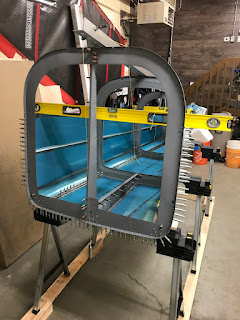One last thing I needed to do before disassembling the aft fuselage was to install the autopilot pitch servo. Unfortunately for me, this is a long a tedious process as I have not drilled the F-728B and F-729B angles yet. (When I drilled the angles on my first attempt the holes did not appear to line up properly, hence when I reordered pieces for me second attempt, I left them undrilled so I could drill them one I can confirm proper alignment).

First order of business was to cleco the top skins to the aft fuselage, this will ensure that the F-706 pieces are all in proper alignment. I could then check alignment of the bellcrank bolt. Alignment looks very good compared to the first attempt.

Oddly enough the factory holes in the channels/webs were spot on. This lead me to believe that on my first attempt there was something up not factory related that caused my alignment to be out. Perhaps the assembly I had originally made was ok, just it not being cleco'ed into proper positions made the alignment way off. Oh well... i'm good now.
I then managed to drill the bellcrank bolt holes F-728B and F-729B angles using pieces from my first attempt as a guide. I set up the drill press and used a 1/4" bit and drilled the holes, then reassembled in the aft fuselage.
Next I needed to locate the autopilot mounting plate 3.43" measured from the center of the bellcrank bolt to the front face of the mounting plate flange. Not as easy to measure as you would think as the angle of the mounting plate is not perpendicular with the top or bottom of the F-729 channel. I figured the best way was to measure and mark a plywood spacer to help.


Once the mounting plate is positioned, its easy to drill the #30 holes at the top. The holes along the bottom flange take a bit of head scratching. The installation manual states the bottom flange can be removed, but I decided to keep it as it will provide a more solid mounting point. I marked out on the bottom of the flange where the mounting holes for the adjacent channel line up and choose to drill new holes in between, like this.

I figure it's most advantageous to stagger the rivet holes rather than keep then aligned. Also, figuring out the distance from the edge to drill the #40 holes was a bit of a head scratcher. Since the mouning plate is 0.050" thick I will countersink for the rivets. The MIL-Spec states minimum edge distance for 3.32" countersunk rivets is 0.219". I opted to use 0.240" from the edge of the flange. Once the holes were drilled in the flange, I used the long #40 drill bit to drill to the bottom of the aft fuselage.














































